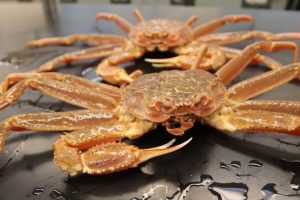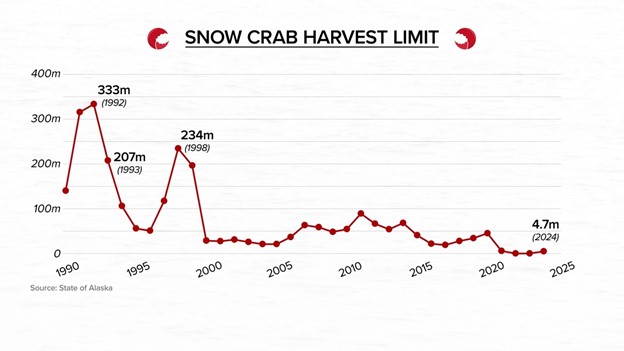Alaska Opens Snow Crab Fishery for First Time in Two Years, Allowing 4.7 Million Pound Harvest
 The Alaska Department of Fish and Game (ADF&G) announced that the Bering Sea snow crab fishery will reopen after being closed for two years, allowing fishermen to harvest approximately 4.7 million pounds of snow crab. This decision follows an assessment that the population of mature male crabs has increased above the threshold necessary to support sustainable fishing.
The Alaska Department of Fish and Game (ADF&G) announced that the Bering Sea snow crab fishery will reopen after being closed for two years, allowing fishermen to harvest approximately 4.7 million pounds of snow crab. This decision follows an assessment that the population of mature male crabs has increased above the threshold necessary to support sustainable fishing.
The 2024/25 Bering Sea snow crab fishery opened in Bering Sea District waters west of 165° W longitude at 12:00 noon on October 15, 2024 and will close at 11:59 p.m. May 15, 2025 in the Eastern Subdistrict (east of 173° W longitude), and close at 11:59 p.m. May 31, 2025 in the Western Subdistrict (west of 173° W longitude).
The reopening of the snow crab fishery comes as a relief to many in the fishing industry, especially those in coastal Alaska communities that rely heavily on the income generated by the snow crab harvest. The fishery was closed for the past two years due to sharp declines in the crab population, which raised concerns about overfishing and environmental changes affecting the crab habitat. In 2021, the ADF&G took the extraordinary step of shutting down the snow crab fishery after population surveys revealed a dramatic crash in crab numbers, likely linked to rising ocean temperatures, reduced sea ice, and ecosystem changes.
The reopening of the fishery is seen as a sign that snow crab populations are stabilizing, although experts urge caution, noting that long term sustainability is still uncertain. The ADF&G’s assessment showed that the total mature male biomass, which refers to the number of crabs that are breeding age and size, has increased enough to justify a limited reopening of the fishery. Under current management rules, snow crab fishing is allowed only when the population reaches a minimum biomass threshold, which ensures that the fishery is being managed responsibly and that stocks are given the chance to recover fully.
The North Pacific Fishery Management Council (NPFMC), which works closely with the ADF&G on managing crab stocks, has also been monitoring the situation closely and supports the reopening with strict limits. The council continues to advocate for strong fishery management to ensure the recovery is not short-lived and that populations can thrive despite ongoing environmental challenges.
Snow crab is a significant component of Alaska’s seafood industry, and the past two years of closures have had ripple effects on coastal communities, seafood processors, and the broader state economy. In years past, snow crab was one of the most lucrative fisheries in the state, with millions of pounds of crab being caught, processed, and shipped to markets worldwide. The closure left many fishing crews without work and created uncertainty for seafood processors.
 Although this is good news for consumers and the crabbing industry, there are concerns about the future of snow crab populations, especially in the context of climate change. Rising sea temperatures and changes in the Bering Sea ecosystem have had extreme impacts on marine life, with scientists cautioning that snow crab populations could be vulnerable to further declines if these conditions persist. Environmental groups and fisheries managers alike are watching closely to see how the population responds to this season’s limited harvest.
Although this is good news for consumers and the crabbing industry, there are concerns about the future of snow crab populations, especially in the context of climate change. Rising sea temperatures and changes in the Bering Sea ecosystem have had extreme impacts on marine life, with scientists cautioning that snow crab populations could be vulnerable to further declines if these conditions persist. Environmental groups and fisheries managers alike are watching closely to see how the population responds to this season’s limited harvest.
As fishermen prepare to resume harvesting snow crab in the Bering Sea, the delicate balance between economic needs, consumer demand, and environmental sustainability remains at the forefront of discussions, with stakeholders hopeful that responsible management will lead to a lasting recovery of Alaska’s snow crab stocks.
 Maritime Injury Law Blog
Maritime Injury Law Blog

